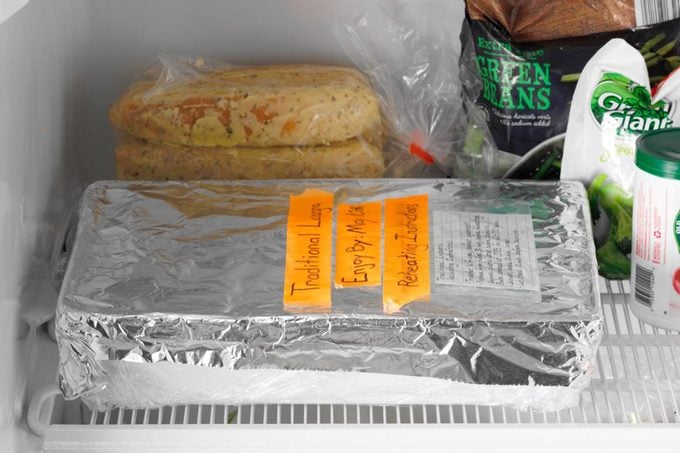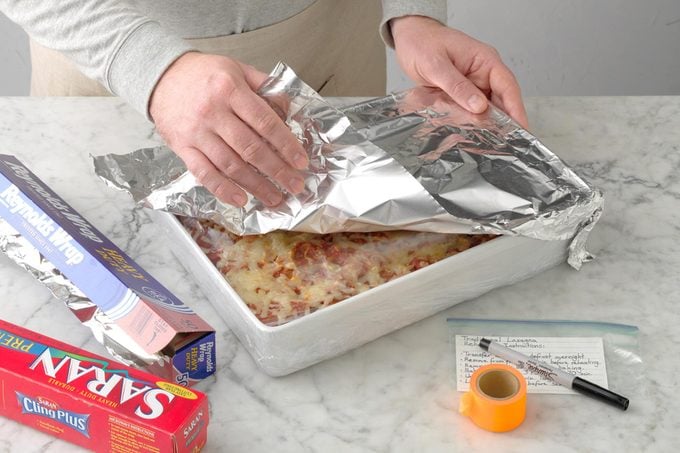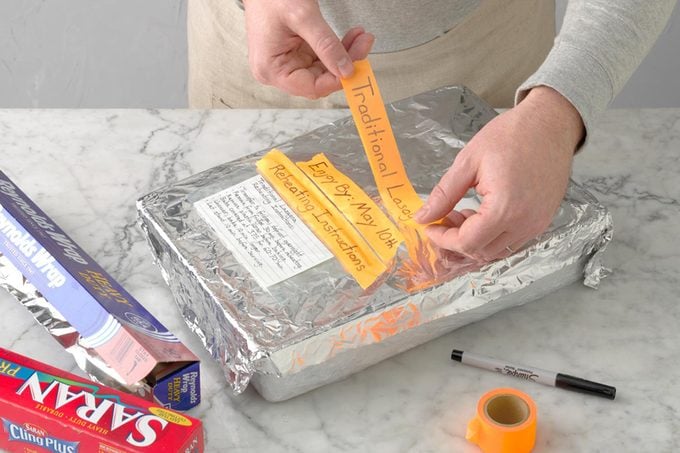How to Freeze Lasagna the Right Way
Updated: Apr. 22, 2024
Learn how to freeze lasagna so it tastes freshly baked. We'll explain how to reheat it, too.
As delicious as a slice of lasagna is, making it each time a craving hits can definitely be a chore. Between making the sauce and cheesy filling, boiling noodles, assembling it all and baking, sometimes I’m too tired to actually enjoy my homemade lasagna.
So, to make life a little easier—and honestly, so I always have some lasagna at my beck and call—I’ve taken to keeping a prepared lasagna in my freezer. Usually, this means prepping and assembling two lasagnas at once (one to be enjoyed right away, the other to be frozen), but freezing can also be a great make-ahead option for a single lasagna.
If you want to learn how to freeze lasagna, keep reading to get the step-by-step instructions.
What’s the best container for freezing lasagna?
Consider the dish you’ll assemble and freeze your lasagna in. A disposable pan is a great choice because you can toss it after it’s used (nothing to clean!) and you’ll still have access to your pans and casserole dishes. If you plan on using a glass or ceramic dish, double-check that it has been tempered, or else it can crack in the freezer.
How to Freeze Lasagna
For the best results, freeze lasagna after it has been assembled but before it’s been baked. Freezing food this way will help maintain the lasagna’s cheese and noodle texture and prevent it from getting soggy. If you’ve already baked your lasagna, don’t worry; it can still be frozen! Just know the texture might be a little different than freshly baked.
Directions
Step 1: Cool it down
Assemble your favorite lasagna recipe, then let it cool completely. Popping a hot lasagna into your freezer can cause other items in your freezer to start to defrost, which can affect their taste and texture, or cause bacteria to develop. Plus, freezing a hot lasagna can cause ice crystals to form throughout, leading to freezer burn and a mushy reheated lasagna. Trust us, taking the extra time to cool the lasagna is definitely worth it.
Step 2: Wrap it up
Once your lasagna has cooled, wrap it snugly with plastic wrap and foil. This will keep air from reaching the lasagna, preventing freezer burn and preserving its flavor and texture. To do so, first wrap the entire lasagna, pan included, in plastic wrap. Try to get the plastic wrap as close to the lasagna’s surface as you can to block out air. Then, cover the top of the wrapped lasagna with a piece of foil to secure it.
If you’re freezing a baked lasagna, you can also cut it into individual servings first. Transfer the slices of lasagna into freezer-safe food containers or wrap the slices first in plastic wrap and then in foil, and store them in a freezer storage bag.
Step 3: Label and freeze
Before you put your lasagna in the freezer, label it! We like to write the recipe name, best-by date and reheat instructions on bright masking tape and place them on the foil. You can write directly on the foil, just make sure you don’t puncture it while writing.
Editor’s Tip: If you’re using a glass or ceramic dish, place the room temperature lasagna in the refrigerator for a few hours before freezing, until it’s below 40°F. Too much of a temperature change too quickly can cause these dishes to break, and refrigeration helps bridge the difference.
How to Reheat Frozen Lasagna
When you’re ready to use your frozen lasagna, transfer it to the refrigerator and let it defrost overnight. Then, take it out of the fridge and let it sit at room temperature for about 30 minutes while your oven preheats to 375°.
Remove the lasagna’s freezer wrappings, cover the top with new foil and bake for 60 to 70 minutes, or until heated through (a thermometer inserted in the center should read 165°). Remove the foil and bake the lasagna for 10 more minutes or so to brown the top. Pull the lasagna from the oven and let it sit for another 10 minutes before slicing into it.
Editor’s Tip: To reheat a previously baked lasagna, follow the same instructions as listed above.
How to Reheat Slices of Lasagna
To reheat individual portions, defrost and bring to room temperature as instructed above. Preheat your oven to 350°, then bake one portion in an oven-safe dish for 30 minutes, or until a thermometer inserted in the center reads 165°.
Serve lasagna with additional sauce, cheese and fresh herbs for a dinner that’s sure to hit the spot.
How long does frozen lasagna last?
Frozen, baked or unbaked lasagna will last up to three months in the freezer. Before reheating it, give the dish a once over for any discoloration or odd smells that could indicate spoilage.
Next up: Learn how to reheat lasagna, refrigerated or frozen, in four ways.






















